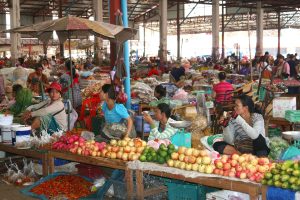According to a recent World Bank report, the number of registered Laotian migrants in Thailand increased by 15 percent between June 2023 and February of this year. The total number, including unregistered migrants, is undoubtedly much higher. For some, this is a sign of just how bad things are in Laos, which has experienced a major economic crisis since 2021, with inflation rates among the highest in Asia and the local currency in freefall. Wages have dried up as the cost of living has doubled, if not tripled, in recent years.
As Zachery Abuza recently argued, large-scale emigration to Thailand signals that “there is simply no future for Lao youth.” In fact, emigration is the reason why Laos has garnered some rare international headlines over the past few years. A BBC piece last year opened, “Confronted with a barren job market, the Vientiane resident holds no hope of finding work at home and instead aims to become a cleaner or a fruit picker in Australia.”
Vientiane isn’t happy about the rush of emigrants over the past few years, not least because it includes many of the more qualified Laotians. My guess, based on the limited data available, is that 90,000 Laotians migrated officially last year, up from around 51,000 in 2022. Again, because many people don’t migrate officially, the actual number is probably much higher. Then again, the communist government is also thankful that disaffected Laotians can emigrate rather than remain and grow even more resentful of their fate.
But one shouldn’t overstate how dire this is. Quite simply, Laos was always going to face increased emigration from 2020 onward. The working-age population in neighboring Thailand was set to peak in 2020 because fertility rates stopped being at replacement levels by the early years of the 1990s. Put simply, we have known for the past 30 years that Thailand was going to start experiencing a major demographic collapse this decade. Between 2020 and 2050, Thailand’s working-age population will decline by a third, from 50 million to 38 million, according to U.N. projections.
Fortunately for Thailand, it’s surrounded by Cambodia, Myanmar, and Laos. For the most part, all three states share a similar culture and religion as Thais, and all have a long history of emigration to Thailand. Moreover, all three states will see their working-age populations increase over the next two decades. The number of 15-to 64-year-olds in Laos, for instance, is forecast to grow from around 4.9 million today to nearly 6.7 million by 2050, an extra 1.8 million people of working age. So, economic crisis or not, Laos was always going to face losing an increasing number of young workers to Thailand from this decade onward because, quite simply, Thais stopped having enough children in the 1980s and 1990s.
Suppose you were in Vientiane prior to 2019. You could reasonably assume that Thailand’s demographics would always lead to increased emigration from your country over the coming decades. However, you could look at your own country’s demographics and be content that enough youths were entering the workforce each year to compensate for those emigrating. In 2020, there were around 2.2 million Laotians under the age of 14. By 2050, there will be around 2.1 million. Demographically, that’s good news. This isn’t an exact figure, but maybe around 150,000 youngsters will enter the workforce each year between now and 2050. So, you could see 150,000 workers leave for Thailand annually, and you’d have a similar number of people ready to take up their jobs. Moreover, in 2019, you might have been optimistic that the very healthy economic growth Laos enjoyed for most of the 2010s could have been converted into increased expenditure on education, meaning that the young Laotians entering the workforce between 2020 and 2050 would be better educated and more productive than those leaving to work in Thailand.
The problem, however, is that the economic crisis since 2021 has gutted the education sector. School non-attendance rates have spiked as families have moved back to the countryside to grow their own food (a bandage for inflation), taken their children out of school so they could work and provide an extra income, or because they couldn’t afford the most basic things like textbooks, transportation, meals, and uniforms that they are expected to pay for. According to a report by Radio Free Asia, which cited a Lao Statistics Bureau report from the end of May, the number of students completing middle school has fallen to 68,800 this year from 76,300 in 2023 and 83,000 in 2022. The number of high school graduates fell to 46,700 this year compared to 50,000 in 2023 and 55,800 in 2022. I hear university attendance rates have fallen by an even larger measure. The same report noted that the number of students at the National University of Laos, the country’s most prestigious university, fell to 6,000 in 2023, compared with 9,000 in 2021.
On top of that, education expenditure by the state has fallen significantly, and the country’s debt crisis, separate from the ongoing economic one, means the state is unlikely to raise spending anytime soon. Even if more students wanted to attend schools, teacher numbers have plummeted as state salaries stagnated. There’s good reason to talk of a “lost generation” of Laotians.

































